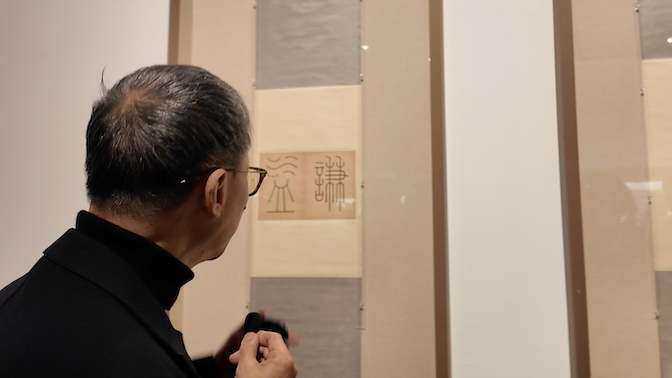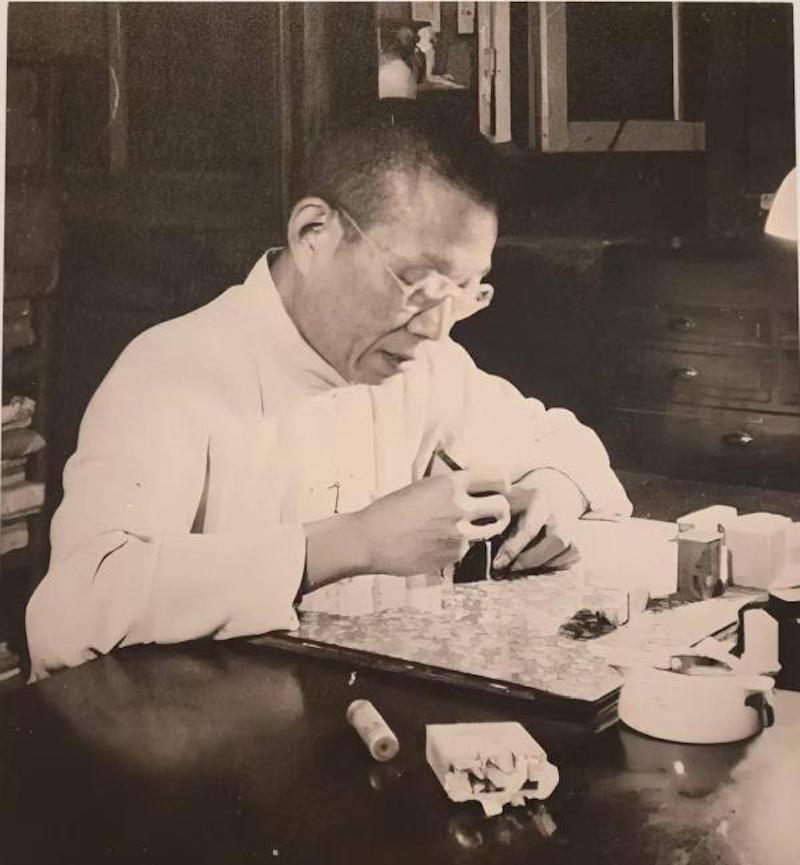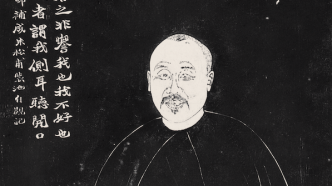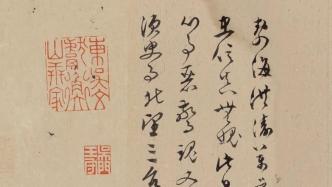
Today is the last day of the "Roaming the Universe - The Rise of Modern Shanghai School Seal Carving and the Academic Exhibition of Seal Carving by Lai Chusheng, Chen Julai and Ye Luyuan" at Shanghai Cheng Shifa Art Museum. This exhibition focuses on the artistic journey of the three famous Shanghai School seal carvers, Lai Chusheng, Chen Julai and Ye Luyuan, and is also one of the largest academic exhibitions of seal carving in recent years.
On April 2, the Research Department of Shanghai Chinese Painting Academy and the Calligraphy Department of the Academy of Fine Arts of East China Normal University held an academic symposium on Shanghai seal carving titled "Spring Waves Moving the Golden Jar". They invited Tong Yanfang, a well-known seal carver and vice president of Xiling Seal Society, to talk about the artistic achievements of Lai Chusheng, Chen Julai and Ye Luyuan on the topic of "Trivia about Seal Art". At the event, Tong Yanfang also combined his own collection to talk about his interactions with the three seal carvers.

Communication with Lai Chusheng
Lai Chusheng, Chen Julai and Ye Luyuan were the first batch of painters of Shanghai Chinese Painting Academy and members of Xiling Seal Society. Their fame in seal carving is self-evident. Among them, Lai Chusheng is another master who has achieved great success in calligraphy, painting and seal carving after Wu Changshuo and Qi Baishi in modern times. He has a deep study of ancient seals of pre-Qin Dynasty, general seals of Han and Wei Dynasty, and school seals of Ming and Qing Dynasty. His unrestrained, simple and powerful freehand seal style is unique and has opened a door for later seal carvers.

Lai Chusheng in his middle age making seals at home
In 1968, Tong Yanfang met Ruopiao, Tang Yun and Lai Chusheng successively and became their disciples. Today, as a collector, Tong Yanfang also focuses on collecting his teachers' calligraphy and seal carving works, hoping to learn from them and promote their artistic achievements and artistic ethics.
Lai Chusheng's portrait seals are the most beautiful and unique in the seal forest. The subjects of his portrait seals are extremely wide. In addition to zodiac animals, Buddha statues, and human portraits, there are also flowers, grass insects, stories, idioms, etc. The brushstrokes are concise and concise, and the expressions are fully expressed, which is interesting. Lai Chusheng's discussion on portrait seals is concise and insightful. He said: "The portrait seal does not need to be too lifelike, nor should it be unlifelike. If the portrait is too lifelike, it will be too vulgar, and it will be out of character. It is necessary to be able to understand the feelings of the object, grasp the characteristics, and seek the lifelike in the likeness and non-likeness."

Tong Yanfang's lecture on "Trivia about Seal Art"
During the lecture, Tong Yanfang shared several of Lai Chusheng's seal carving works from his collection and told the stories behind them:
"In the seals carved with Buddha statues, we can see that he used the knife skillfully, but he was also able to express the soft texture of the Buddha statue's clothing. In the multi-person modeling, he easily distinguished the different textures; and in the seals carved with tigers, he also showed the softness of the tiger's claws, and with just a few cuts, he carved out the texture of the tiger's chest mane.

Lai Chusheng's seal carving works

Lai Chusheng's seal carving works
"In 1973, I got a piece of stone with very good texture. There were some cracks on the top and it was not smooth. I thought it was very good, so I took it to Mr. Lai to see. After he saw it, he carved the zodiac signs of my whole family on it, including snake, rabbit, monkey, pig and dog. The pig and dog are the zodiac signs of me and my wife respectively, and the monkey is the zodiac sign of my mother. From the Qinglong, White Tiger, Vermillion Bird and Black Tortoise of the Han Dynasty to the development of carving the zodiac signs on one seal, this is Mr. Lai's great innovation.

Lai Chusheng's seal carving works. The left picture shows a family portrait seal carved by Lai Chusheng for Tong Yanfang.
"In the 1950s, Mr. Lai, like other calligraphers and painters, created many new themes. For example, the seals I collected have patterns of people playing waist drums and reading newspapers, and a seal with spiders and spider webs, which were created by Mr. Lai and Tang Yun. These seals are all 'new wine in old bottles'.
"There is a seal that I worked on with Mr. Lai, engraved with Du Shaoling's poem "The gate is afraid of frequent guests". One day in the 1970s, Mr. Lai's friend asked about the level of his students. So after Mr. Lai finished writing the draft for the seal, he said "carved by a child". Later, Mr. Lai gave this seal to me as a souvenir. Of course, Mr. Lai had done some work on the seal, and the most wonderful parts were from his hand.

Lai Chusheng's seal carving works, the picture on the right is the carving of "Playing the Waist Drum"

Manuscript of "Ranxishi Seal Study Heart Seal"
"The manuscript of 'Ranxishi Seal Carving' that he gave me records Lai Chusheng's creative experience and ideas in seal carving. The seal examples in the manuscript were all traced by Mr. Lai with a red pen."
Looking at the portrait seal and text seal of Future Chusheng together, we can see the unity of Mr. Li’s knife and white space, which can be said to be “consistent”. “Character” is “painting”, and “painting” is also “character”, which is truly the work of a master. During the lecture, Tong Yanfang also told the stories behind many calligraphy and painting works. Among them, “Two Poems by Chairman Mao to Send to the God of Plague” was written on couplet paper. "In the 1970s, I carved a small seal for a friend, and my friend gave me a pair of very good blank couplets. At that time, paper was precious and I was reluctant to write on it, so I turned the paper sideways, made grids on it, and asked Mr. Lai to write. The other couplet was proposed by Mr. Lai to ask Mr. Zhang Dazhuang to paint. So, a pair of blank couplets turned into two excellent works. The other work was written in 1973. At that time, he was studying Han bamboo slips. I brought a piece of thin paper that he liked, and asked him not to make grids, but to write as he liked, and sign it in official script. This is a happy thing that I will never forget." In addition, there is a Chu Sheng album with Tang Yun's inscription "Vivid and Colorful", which was obtained by Tong Yanfang in exchange for a work by Lin Fengmian.

Lai Chusheng, "Two Poems by Chairman Mao to Send Away the God of Plague" (partial)
December 2024 marks the 120th anniversary of Lai Chusheng's birth, and February 2025 marks the 50th anniversary of his death. In memory of his teacher, Tong Yanfang collected and carefully collected over decades, selected 80 seal carving works by Lai Chusheng, compiled and copied the seal collection "Bao Yan Zhai Collection·Ran Xishi Seal", and provided first-hand information for the academic community to deeply explore Lai Chusheng's seal carving art. "The little achievements I have made in calligraphy and seal carving today can be said to be the gift of my teacher, which I will remember for the rest of my life," said Tong Yanfang.

Collection of Seals from Baoyanzhai Collection: Seals of Ranxishi
Pasting seals for Chen Julai
In sharp contrast to Lai Chusheng's freehand style is Chen Julai's meticulous seal work. Chen Julai, originally named Jia, with the courtesy name Julai, later used his courtesy name as his name, and was also known as Shangzhai and Anchi. His works were highly praised by famous artists and scholars, and there was an endless stream of people who came to ask for seals. He had a deep friendship with Zhang Daqian, Pu Xinyue and others, and often made seals for them. Many of his masterpieces were circulated with the paintings of these famous artists. For example, his seal "Diyi Rare" was engraved by Ye Gongchuo and printed on Wang Xianzhi's "Yatouwan Tie".

Chen Julai making seals at home in his later years

On the left is the inscription "The First Rare" by Chen Julai
In learning seal carving, Chen Julai studied under the famous seal carver Zhao Shuru in his early years and learned his true teachings. At the same time, he devoted himself to studying ancient seals and Han seals and the seal styles of the Ming and Qing dynasties, absorbing the essence of each school. Zhao Shuru introduced Chen Julai to Wu Hufan, who was rich in collections. The latter generously lent him twelve volumes of Wang Guan's "Baoyinzhai Seal Style" from his family collection for reference. After seven years of dedicated research, Chen Julai became proficient in seal carving and became more skilled and mature. Later, Chen Julai saw Pinghu Ge Shuzheng's "Ivory and Rhinoceros Horn Seals of the Three Dynasties of Yuan, Ming and Qing Dynasties", and then specialized in Yuan Zhuwen. Zhao Shuru praised him for his "mellow seal carving, and Yuan Zhuwen is the best in modern times", which was widely circulated and became his "label".

(Left) Zhao Shuru praised Chen Julai for his "rich engravings and his Yuan Dynasty red characters as the best in modern times"
Regarding Chen Julai's seal carving, Tong Yanfang said, "He repeatedly traced and carved the sample he was studying, which showed that he put a lot of effort. What he traced and carved was exactly the same as the original, so he was very refined and meticulous, and reflected these characteristics in his own works."
During the lecture, Tong Yanfang talked about the past experience of pasting seal albums for Chen Julai: "Mr. Julai is extremely rigorous. His works named "An Chi Jing She" are meticulous and exquisite. In the past, Shanghai Chinese Painting Academy always held the Spring Festival Painting Exhibition. He often thought that the seal albums in the exhibition were not pasted well and was not satisfied. In 1978, I entered the painting academy and was responsible for pasting seal albums for him in the Spring Festival Painting Exhibition. This time, he was very satisfied and said that I pasted well. In 1982, when the publishing house was going to publish his "An Chi Jing She Seal Collection", he asked me to help check it."

Seal of Anchi Jingshe
After the publication of Anzhi Jingshe Yinquan, Chen Julai presented a copy to Tong Yanfang, with the inscription on the title page: "Comrade Yanfang is a generous and upright man. On the 26th day of the 12th month of the Renxu year, Chen Julai presented it to me respectfully. I was 78 years old at that time."
Chen Julai also loved to paint pine trees, and once made his own seal with the words "Julai Painting Pine Trees", which fully demonstrated the essence of Yuan Zhuwen. During the lecture, Tong Yanfang also displayed a small painting of pine trees given by Chen Julai, which was neatly and meticulously painted.

The pine tree painting presented by Chen Julai to Tong Yanfang
Ye Luyuan, a moderate and peaceful person
Ye Luyuan, whose given name was Feng and whose pen name was Feng, was from Wuxian County, Jiangsu Province. At the age of thirteen, he entered Futai Money House to learn about finance, and worked as an accountant and salesperson. Later, he moved to Siming Bank, where he served as chief cashier, assistant manager, and deputy manager until the early 1950s when private banks were reformed. Compared with finance, he loved art more. At the age of 16, he studied under Zhao Shuru, and after work, he always stayed by his side to listen to his tips on painting and seal carving. After more than thirty years of hard work, he enjoyed a great reputation and was hired as a painter when the Shanghai Chinese Painting Academy was established in 1956.

Ye Luyuan
Although Ye Luyuan and Chen Julai both studied under Zhao Shuru, they learned different styles. The former had a deep study of the Anhui and Zhejiang schools of seal carving, and also put a lot of effort into the study of Qin and Han seals. Tong Yanfang said, "His seal carving, no matter what style, reveals a pleasing atmosphere. Every time he makes a seal, he is never careless, and he takes in all the subtleties, integrates them, and must be thorough and complete before he can be accepted. In general, his seal style is between the refined and the relaxed, moderate and peaceful. Mr. Yulai and Mr. Julai are each good at their own strengths."
Due to his wealthy family, Ye Luyuan collected many original seals of the Ming and Qing dynasties, especially the "Four Masters of Xiling". In order to learn, he also collected seal collections, and later donated part of his collection to the Shanghai Chinese Painting Academy. As a colleague at the painting academy, Tong Yanfang participated in the sorting of the donations and benefited a lot.

Ye Luyuan's "Jingle Pavilion Seal Manuscript"
Looking back, Tong Yanfang said, "Mr. Ye lived the longest among the three, at the age of 88. They had different artistic styles, different ways of doing things, and even more different personalities. Mr. Ye never took a nap and was a very quiet person. At the same time, he had a good relationship with his friends. For example, he had a close friendship with another seal engraver, Wang Fuan, and through the latter's introduction, he borrowed the "Fu Lu Collection of Seals" from Chen Handi's collection. This collection of seals contains more than 600 seals. Mr. Ye was able to borrow it from Chen Handi for two years, which shows that he has a very good reputation."

Ye Luyuan's seal carving works
Among Tong Yanfang's seal collection, there is a "Ye Feng Zhi Xi" seal carved by Lai Chusheng for Ye Luyuan. "One day, I came to Mr. Ye's house and wanted to borrow it to take a look. Mr. Ye said, 'No problem, you can make further requests.' I said, 'Further requests mean giving it to me.' Mr. Ye said that was what he meant, and gave me the seal."
The Tonggu Book Hall Collection of Seals consists of four volumes, which are compiled by Cha Li in chronological order. It is rich in content. "Mr. Ye once told me that he bought a copy of the Tonggu Book Hall Collection of Seals, and then he wrote an inscription. In 1987, when I moved to a new home and lived on the 4th floor, he personally came to my house and gave me the book, which was very touching," Tong Yanfang recalled.

The "Tonggu Book Hall Collection Seal" presented by Ye Luyuan to Tong Yanfang

Ye Luyuan Flower and Bird Album
In addition, influenced by his teacher Zhao Shuru, Ye Luyuan devoted a lot of energy to painting, mostly in the style of Yun Nantian's boneless and colored painting, which was elegant and bright. His seal carving style was very similar to that of his predecessor.

The scene of the academic symposium on "Spring Waves Moving the Golden Jar" Shanghai School of Seal Carving
Regarding the "Roaming the Universe" special exhibition and the "Spring Waves Moving the Golden Jar" event, Tong Yanfang said, "In recent years, as the popularity of epigraphy continues to rise, seal carving has become a highly popular art category. Now, everyone's creative ideas are active, and the enthusiasm for seal carving has reached a new height. Inheriting traditions and developing seal carving art has become a topic of artistic development now and in the future."
"It is very inspiring to watch the works of the three. They chose their own paths according to their own personalities and persisted on them. In addition to seal carving, they worked hard on calligraphy and would paint in order to find a kind of synaesthesia. Today, their works have become a good model, showing the way to learn and create." Tong Yanfang concluded.
- aAHQXGjdLqwppH04/07/2025
- XJlMLzLYRxkqltY04/07/2025


